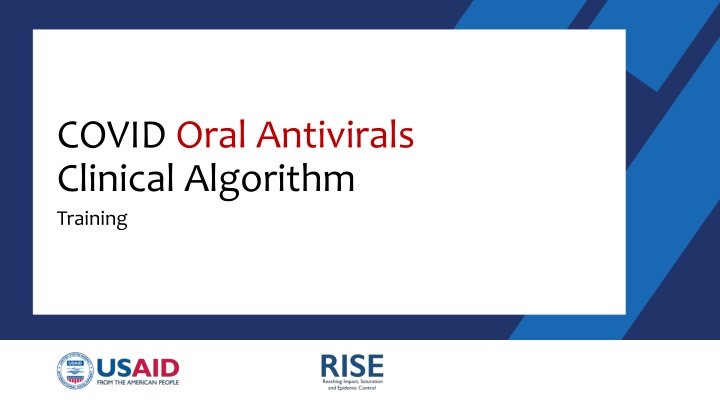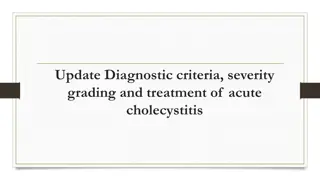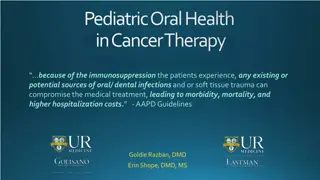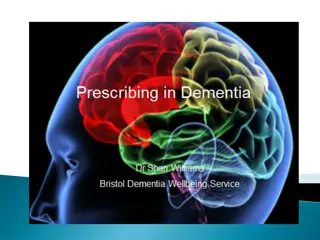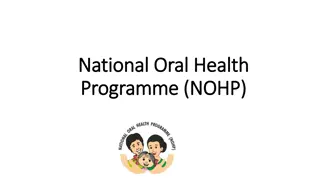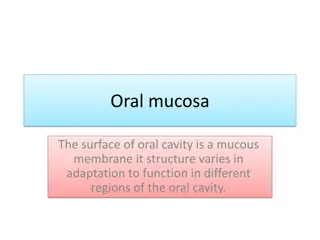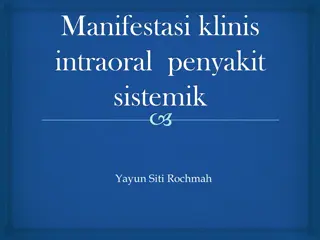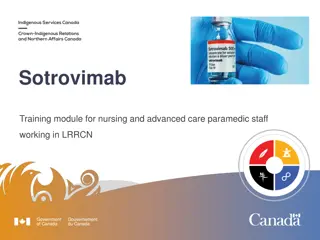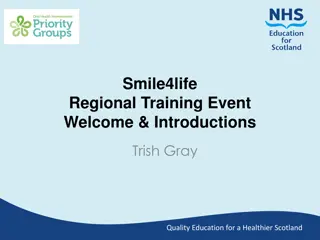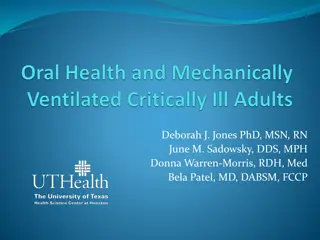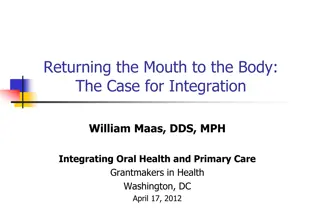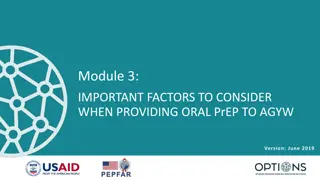Oral Antivirals for Mild-to-Moderate COVID-19 Treatment Algorithm Training
Explore the use of oral antivirals such as Paxlovid and Molnupiravir for treating mild-to-moderate cases of COVID-19. Learn about the efficacy, dosing, and dispensing guidelines to reduce hospitalizations and deaths, especially in low-resource settings. Discover the latest clinical algorithms and trials supporting these treatment options.
Download Presentation

Please find below an Image/Link to download the presentation.
The content on the website is provided AS IS for your information and personal use only. It may not be sold, licensed, or shared on other websites without obtaining consent from the author.If you encounter any issues during the download, it is possible that the publisher has removed the file from their server.
You are allowed to download the files provided on this website for personal or commercial use, subject to the condition that they are used lawfully. All files are the property of their respective owners.
The content on the website is provided AS IS for your information and personal use only. It may not be sold, licensed, or shared on other websites without obtaining consent from the author.
E N D
Presentation Transcript
COVID Oral Antivirals Clinical Algorithm Training
Coronavirus Disease (COVID-19) Most common symptoms: fever cough tiredness loss of taste or smell. Infection caused by the SARS-COV-2 virus. Although severe infection is possible, most infected individuals will experience mild to moderate respiratory illness. Less common symptoms: sore throat headache aches and pains diarrhea rash on skin, or discolored fingers/toes red or irritated eyes The elderly, and individuals with co-morbidities such as cardiovascular disease, diabetes, chronic respiratory disease, or cancer may be more likely to develop severe illness. Medical attention and potential hospitalization for oxygen therapy may be indicated for those who become severely ill. Coronavirus disease (COVID-19). World Health Organization.https://www.who.int/health-topics/coronavirus#tab=tab_3
Oral Antivirals for Mild-to-Moderate COVID-19 q This approach is designed for early detection and treatment of COVID-19 in LMICs to reduce burden on health systems and prevent hospitalizations and deaths q Available oral antivirals (brand name) Nirmatrelvir / Ritonavir (Paxlovid) Molnupiravir q Current evidence/guidelines support Nirmatrelvir/Ritonavir as preferred q Clinical algorithm can accommodate updates to guidelines including new oral antiviral drugs as appropriate
Efficacy Paxlovid The EPIC-HR trial demonstrated that starting ritonavir-boosted nirmatrelvir treatment in nonhospitalized adults with mild to moderate COVID-19 within 5 days of symptom onset reduced the risk of hospitalization or death through Day 28 by 89% compared to placebo Molnupiravir In the MOVe-OUT trial, Molnupiravir reduced the rate of hospitalization or death by 30% compared to placebo PAXLOVID (nirmatrelvir tablets; ritonavir tablets) For Patients Pfizer s Novel COVID-19 Oral Antiviral Treatment Candidate Reduced Risk of Hospitalization or Death by 89% in Interim Analysis of Phase 2/3 EPIC-HR Study | Pfizer
Dosing & Dispensing Paxlovid Molnupiravir 300mg (two 150mg tablets) of nirmatrelvir one 100mg tablet of ritonavir, given twice daily for five days 800mg by mouth twice daily for five days PAXLOVID (nirmatrelvir tablets; ritonavir tablets) For Patients Pfizer s Novel COVID-19 Oral Antiviral Treatment Candidate Reduced Risk of Hospitalization or Death by 89% in Interim Analysis of Phase 2/3 EPIC-HR Study | Pfizer
Paxlovid Indications: Treatment of mild-to-moderate COVID-19 in adults and pediatric patients Aged 12 years and older, and weighing at least 40 kilograms (~ 88 pounds) Positive results of direct SARS-CoV-2 testing, and at high risk for progression to severe COVID-19, including hospitalization or death Paxlovid should be initiated as soon as possible after diagnosis of COVID19 and within five days of symptom onset Contraindications: Age <12 Advanced kidney disease (GFR <30mL/min) Advanced liver disease Severe COVID-19 illness requiring hospitalization Ritonavir-Boosted Nirmatrelvir (Paxlovid) | COVID-19 Treatment Guidelines (nih.gov) Paxlovid Drug-Drug Interactions | COVID-19 Treatment Guidelines (nih.gov)
Molnupiravir Indications: For treatment of adults (>18 years) with mild to moderate COVID-19 who are within 5 days of symptom onset, who are at high risk of progressing to severe disease, and for whom alternative antiviral therapies are not accessible or clinically appropriate. Contraindications: Age <18 Pregnancy Severe COVID-19 illness requiring hospitalization Molnupiravir | COVID-19 Treatment Guidelines (nih.gov)
https://opencritical care.org/wp- content/uploads/2 022/04/COVID-19- Test-to-Treat- Algorithm-v2022.4- 3z26sh.pdf
1 2 3 https://opencritical care.org/wp- content/uploads/2 022/04/COVID-19- Test-to-Treat- Algorithm-v2022.4- 3z26sh.pdf
First steps 1. Do they have Covid? Tests should be completed to confirm or if possible check the results of a home test Do they have severe symptoms? Dyspnea, SpO2 < 94%, new supplemental O2 requirements, confusion, respiratory distress, need to additional labs or imaging? Severe patients require a higher level of care or admission to a hospital Have they had symptoms for less than 5 days? 2. 3.
1 2 3 https://opencritical care.org/wp- content/uploads/2 022/04/COVID-19- Test-to-Treat- Algorithm-v2022.4- 3z26sh.pdf
Are they at high risk of progressing to more severe disease or hospitalization? Age 60 BMI 25 kg/m2 Pregnancy Diabetes Sickle Cell Disease Neurodevelopmental disorder Chronic Kidney Disease, Stage 3b or worse Cardiovascular disease, Hypertension, Lung Disease Immunocompromising condition, including HIV Tuberculosis Clinician-determined medical condition or demographic factor that places the patient at high risk for disease progression
https://opencritical care.org/wp- content/uploads/2 022/04/COVID-19- Test-to-Treat- Algorithm-v2022.4- 3z26sh.pdf
https://opencritical care.org/wp- content/uploads/2 022/04/COVID-19- Test-to-Treat- Algorithm-v2022.4- 3z26sh.pdf
Is the patient a candidate for Paxlovid? 12yo and 40kg If not, pt is not eligible for oral medications Does the patient currently take any medications that interact with Paxlovid? Paxlovid has many Drug-Drug Interactions (DDIs) There are many resources for health care workers to check for specific patient recommendations Liverpool- https://covid19-druginteractions.org/checker NIH- https://www.covid19treatmentguidelines.nih.gov/therapies/antiviral-therapy/ritonavir-boosted- nirmatrelvir--paxlovid-/paxlovid-drug-drug-interactions/ There are many medications that concomitant use is contraindicated In some situations, stopping the medication is too risky for the patient and they should not take Paxlovid. These patients should be assessed for Molnupiravir There are many medications that require dose or regimen adjustments while taking Paxlovid Depending on the risk profile for the individual patient, these medications can be held or dose reduced while taking Paxlovid and typically for 3 days after Is it recommended that women on oral contraceptive pills use another form of birth control while taking Paxlovid
https://opencritical care.org/wp- content/uploads/2 022/04/COVID-19- Test-to-Treat- Algorithm-v2022.4- 3z26sh.pdf
Paxlovid dose adjustment example Oxycodone concentrations may be increased by Ritonavir A dose reduction during and 3 days after taking Paxlovid is recommended Alternative therapies should be utilized during Paxlovid use and Oxycodone use can be resumed 4 days after the last dose of Paxlovid If a patient is unable to tolerate the dose reduction or alternative analgesics, the patient should be monitored for life threatening respiratory depression and somnolence
https://opencritical care.org/wp- content/uploads/2 022/04/COVID-19- Test-to-Treat- Algorithm-v2022.4- 3z26sh.pdf
Is the patient a candidate for Paxlovid? Does the patient have renal failure? GFR <30 = contraindicated GFR 60-30 = reduce the dose of Paxlovid to 1 pill of nirmatrelvir (150mg) and 1 pill of ritonavir (100mg) Does the patient have liver failure? Severe / Child-Pugh Class C = contraindicated Moderate or Mild / Child-Pugh Classes A & B no dose adjustment
https://opencritical care.org/wp- content/uploads/2 022/04/COVID-19- Test-to-Treat- Algorithm-v2022.4- 3z26sh.pdf
Is the patient eligible for Molnupiravir? 18yo Not pregnant or breastfeeding
https://opencritical care.org/wp- content/uploads/2 022/04/COVID-19- Test-to-Treat- Algorithm-v2022.4- 3z26sh.pdf
Case Example A 25yo M with Obesity (BMI 38kg/m2) presents with 2 days of generalized fatigue, body aches, fever, and nonproductive cough. He does not get short of breath while walking, denies vomiting and diarrhea. He has not been tested for COVID. He denies taking daily medications. Think of each case in the current context of your health care system: To which kind of a health care facility would this patient present? Who would be assessing him for antiviral therapy eligibility? Who would order his prescription?
https://opencritical care.org/wp- content/uploads/2 022/04/COVID-19- Test-to-Treat- Algorithm-v2022.4- 3z26sh.pdf
Case Example An 27yo female presents with cough, congestion, and headache for 3 days. She has HIV, takes Biktarvi (Bictegravir/ Emtricitabine/ Tenofovir alafenamide), she does not know her last viral load, and takes oral contraceptive pills. She is fully vaccinated with 2 doses of Moderna. Her vital signs are normal. Her vital signs are normal, she is non-toxic appearing, without neck stiffness, with clear lung sounds, and neurologically intact. Her Covid test results positive in your facility.
https://opencritical care.org/wp- content/uploads/2 022/04/COVID-19- Test-to-Treat- Algorithm-v2022.4- 3z26sh.pdf
Clinical Algorithm Activity Now split up into pairs or small groups and work through some additional cases One person should read the case One person should talk through the algorithm to determine the best care for each patient Switch who reads each case Be sure to consider the specific context of your health care system for each case
